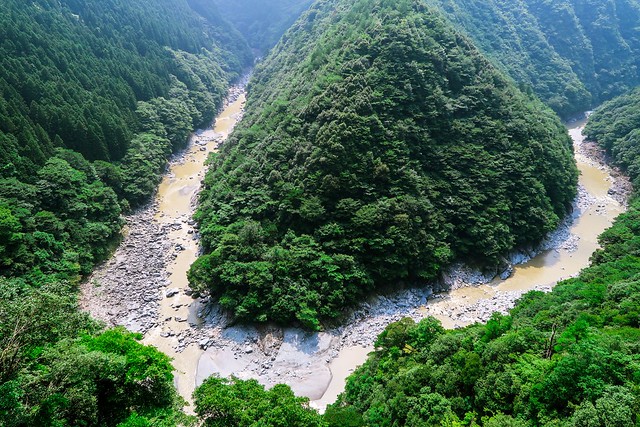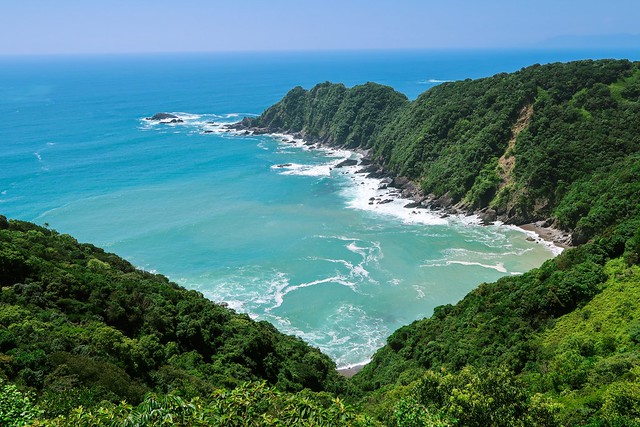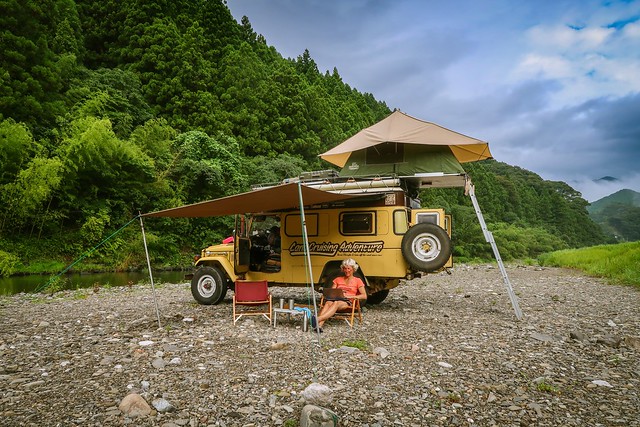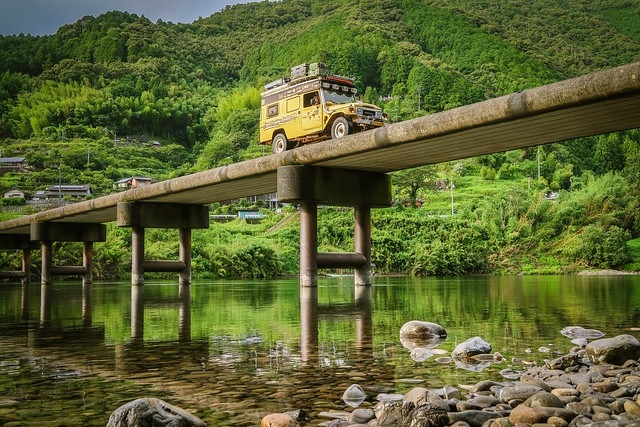One day a man returns after our conversation of mostly smiling and some sign language -after eight months in Japan we haven’t learned enough Japanese to have a proper conversation. On his return he gives us a sheet of paper with a Google translation of his message, “Dinner today near the typhoon will pass. From the early afternoon rain, the wind becomes stronger as the wind, blown You’d better things together!”
How kind is that, to give us notice of a typhoon that’s only hours away. We pack up and drive inland where we stop at a convenience store for a cup of coffee and Wifi in the coffee corner of the shop. The wind is quickly picking up, flattening the rice that is cultivated around the parking lot. All of the sudden, the heavens open their taps and it starts raining cats and dogs with a deafening fierceness. Our friend Masa lives on the nearby island of Kyushu, where the typhoon has just passed. “Don’t drive,” he warns per Messenger. Way too dangerous with your high, squarish vehicle.” Looking outside we see how the Land Cruiser is indeed swaying from left to right and Coen places it right along the side of the building, where it is protected from the squalls.

The typhoon lasts only a few hours and silence returns to the island. We drive on. It is the start of the annual typhoon season and we’ll get some more storms in the weeks to come. Inland lies the Iya Valley, where a road has been cut in the mountain slopes. Below us runs a gorge with vertical walls, with a river cascading at full force at the bottom. The incessant rain keeps us from stopping and taking pictures, until we see something remarkable: life-sized dolls. Everywhere around us: a service engineer fixing the electricity grid, a worker with his electric saw at a wood working company, a group of people sitting on a bench.

This is the work of Ayano Tsukimi. She grew up in this village and moved to a city where she lived for years. On her return she realized how few people had remained. Lack of jobs and shops made many inhabitants swap their lovely home for a world of asphalt, concrete and apartment buildings but where they did have jobs and shops. To remember all these people,Ayano livened up the village with life-sized dolls that give an impression of village life in the old days. She created some 200 dolls for this village and as she became known for her work, others have asked her for dolls too, so the project grew into a source of income for her.
Farther east on the island of Shikoku, bad weather also cuts our inland trip to Tsuno short. Well known for its fabulous karst landscape, we don’t get to see any of it as we drive through the clouds while the rain is streaming against the Land Cruiser windows. Back to the coast it is and along the way we are so charmed by the Shimanto River that we stop to camp for the night. Most rivers in Japan have an artificial look and feel. Part of an attempt to tame nature as much as possible, the banks of rivers generally have been covered in a layer of concrete. The Shimanto River escaped that fate – at least the part we see. We have forgotten what that looks like: green banks and water meandering through the land rather than being hemmed in by a concrete corset and forced to flow in straight lines. We make up camp in a wide riverbed that’s far enough from the river and the ‘sinking bridge’ as they call it; when the water level rises, it will disappear under the water. We have the company of a couple of people canoeing. It’s a lovely late afternoon with clear weather. However, the typhoon turns our way and we retreat into the Land Cruiser. The wind howls, the water level rises. Warnings are echoing over the loud speakers that have been set up for these kinds of events along many rivers and other places on the island. We move camp and next morning we continue our search for good weather.


When the weather is nice, Shikoku is gorgeous. Green mountains inland with the wild rivers rushing through them and a coast lined with many stunning bays. Okhinohama is known as Japan’s most beautiful beach. The high season starts with five days of gorgeous weather. What a stroke of luck. The beach is quickly being cleaned from all the rubbish that had washed ashore during the storms. Around us locals are arriving from the island of Honshuand nearby towns, all setting up camp. Contrary to Europeans, Argentineans and Brazilians,Japanese aren’t particularly fond of the beach, nor noise. Few go sunbathing; most stay near their cars and tents in the shade, having conversations without the need of blaring radios. Kids play in the sand dressed in sun-protective gear and wearing hats. Bikinis are an exception; the adults mostly go swimming in sun-protective clothes. Others wear life jackets on top; many can’t swim. Surfers are lying in the water, waiting for the ultimate wave. Coen takes pictures of them and offers to forward them, which they love and it’s a good way to share time together.

Related Articles
For the first time in some weeks we feel confident enough to put up the rooftop tent, and sit outside in a balmy evening. On the black horizon climbs a red dot, slowly growing into a full,yellow moon which climbs the heavens. The clouds respectfully move aside, allowing her to mirror herself in the Pacific Ocean. What an extraordinary sight. After days of trying to escape bad weather, we feel the luckiest people in the world again.

MORE PHOTOS:
[flickr set=72157713186602003]
To get your copy of the
Fall 2019 Issue:
Follow us on Facebook, Twitter, and Instagram to get up-to-date industry news, events, and of course, amazing adventures, stories, and photos!













